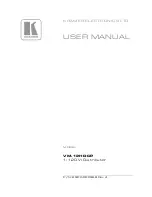
6
out, using a twisting motion to remove
debris. Use a syringe filled with enzymatic
cleaning solution to flush hard to reach
internal areas. When cleaning articulating
instruments, (those with moveable parts),
brush with a soft non-metallic bristle brush
to remove all traces of blood and debris.
Pay close attention to threads, crevices,
seams, and any hard to reach areas.
Actuate any moveable mechanisms,
such as hinged joints, box locks, or
spring-loaded features, to free trapped
blood and debris. If the components of
the instrument can be retracted, retract or
open the part while cleaning the area. For
instruments with flexible shafts, flex the
instrument under the cleaning solution.
• Ultrasonically clean the instrument for
20 minutes at 38-49˚C in neutral pH
detergent, prepared in accordance with
the manufacturer’s instructions.
Rinsing Instructions
Rinse the instrument thoroughly with filtered
water at 38-49ºC, agitate for a minimum of 1
minute; repeat rinse at least two additional times.
When rinsing, pay particular attention to flush
the cannulations, lumens, or holes with warm tap
water. Also pay particular attention to internal
areas and moveable parts. Actuate moveable
parts while rinsing. If the components of the
instrument can be retracted, retract or open the
part while rinsing the area. For instruments with
flexible shafts, flex the instrument under the rinse
solution.
Drying Instructions
Dry the instrument immediately after final rinse.
Use filtered compressed air to dry internal areas.
After drying proceed to Inspection instructions.
INSPECTION AFTER CLEANING
• Inspect all instruments before sterilization
or storage to ensure the complete removal
of soil from surfaces, tubes and holes,
moveable parts.
• If areas are difficult to inspect visually,
check for blood by immersing or flushing
the instrument in a 3% hydrogen peroxide
solution. If bubbling is observed, blood is
present.
Rinse instruments thoroughly
after using hydrogen peroxide solution.
• If soil is still present, reclean the
instrument.
MAINTENANCE
Between uses, lubricate moving parts with a
water-soluble lubricant in accordance with the
manufacturer’s instructions.
INSPECTION AND FUNCTIONAL TESTING
• Visually inspect the instrument and check
for damage and wear.
• Cutting edges should be free of nicks and
have a continuous edge.
• Jaws and teeth should align properly.
• Moveable parts should have smooth
movement without excessive play.
• Locking mechanisms should fasten
securely and close easily.
• Long, thin instruments should be free of
bending and distortion.
PACKAGING
• For instruments that are provided in
sets, instrument trays may be used for
containment during sterilization.
• Package trays/instruments with a barrier
wrap material in accordance with local
procedures, using standardized wrapping
techniques such as those described in
ANSI/AAMI ST46-1993.
Содержание DePuy Mitek 108804
Страница 52: ...52 ExpresSew ll ExpresSew ll 2 ExpresSew ll 5mm 3 4 5 6 DePuy Mitek...
Страница 53: ...53 INSTRUMENTS pH 4 pH...
Страница 54: ...54 3 60 C 20 1 82 2 C 5 95 C 10 30 C 20 38 49 C pH 38 49 C 1...
Страница 55: ...55 3 ST46 1993 ANSI AAMI DePuy Mitek DePuy Mitek...
Страница 76: ...76 1 ExpresSew ll 1 3 1 2 3 G ExpresSew ll ExpresSew ll 2 0 2 2 ExpresSew ll 5 3 4 5...
Страница 77: ...77 6 DePuy Mitek...
Страница 78: ...78 pH 4 pH 3 60 C 20 1 82 2 C 5 95 C 10 30 C...
Страница 79: ...79 20 38 49 C pH 1 38 49 C 3...
Страница 90: ...90 3 G ExpresSew ll ExpresSew ll 2 0 2 2 ExpresSew ll 5 3 4 5 6 DePuy Mitek...
Страница 91: ...91 pH 2 4 pH 60 C 3 20 82 2 C 1 95 C 5 10 30 C pH 38 49 C 20 38 49 C 1 3...
Страница 97: ...97 6 DePuy INSTRUMENTS pH 2 4 pH 60 C 3 20 82 2 C 1 95 C 5...
Страница 98: ...98 10 30 C 38 49 C pH 20 38 49 C 1 3...
Страница 99: ...99 ANSI AAMI ST46 1993 DePuy DePuy pin mat 132 134 C 4 134 137 C 3...
Страница 100: ...100...







































